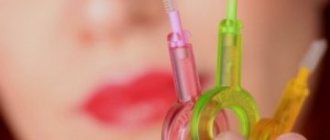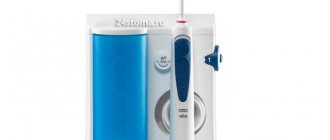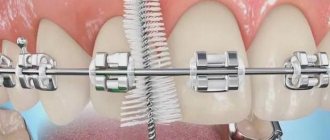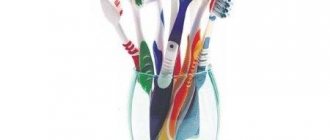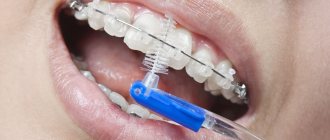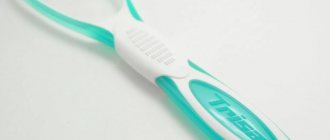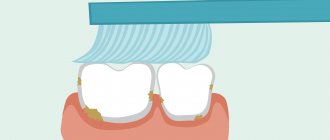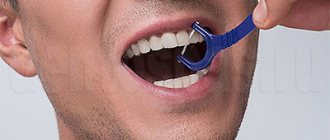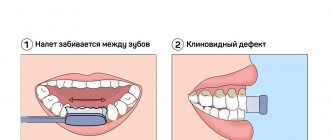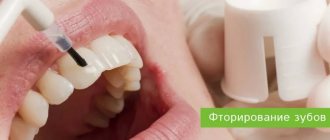We were all taught from early childhood to brush our teeth every day. Now there are a huge number of different types of toothbrushes: with carbon coating, with multi-level bristles, electric with a vibrating body and regular ones. But still, the possibilities of the brush are not limitless, and often it cannot cope with hard-to-reach places, such as the gaps between the teeth at their base. This problem was solved by special dental brushes, which were originally developed for oral hygiene of people wearing braces. What kind of device is this? How effective is it? What models are there and how much do they cost? The editors of the YaNashla website have prepared answers to all these and other questions for you.
What is a dental brush for?
People use a baby bottle brush when they need to remove milk residues that could not be removed with regular water. The situation is similar with dental brushes. They are used if necessary:
- remove pieces of food from the interdental spaces that cannot be rinsed with water or removed with a regular toothbrush;
- clean the back surface of the teeth;
- ensure better oral hygiene.
There are a number of medical indications for which it is necessary to use a dental brush:
- wearing braces;
- presence of dental prostheses or implants in the mouth;
- periodontal pathology;
- a large number of diastemas and three;
- crowded teeth and their irregular shape;
- smoking and frequent consumption of coloring products;
- chronic diseases that, even in a vegetative state, have a bad effect on the microflora of the oral cavity.
Indications
A brush is an additional device for dental care, but dentists recommend that some categories of people use it. The main indications for use of the product are:
- wearing braces, dentures, implants and other orthodontic and orthopedic structures;
- large spaces between molars;
- crowding and irregular shape of crowns;
- presence of malocclusion and gum disease;
- discoloration of enamel due to smoking, consumption of products with dyes;
- accelerated formation of bacterial plaque due to impaired acid-base balance in the oral cavity.
In addition, it is advisable to use a brush daily to prevent various dental diseases, as an addition to a brush.
Read how much it costs to insert a tooth and what the cost of prosthetics is made up of. Click here if you are interested in how you can restore tooth enamel at home.
At this address https://dr-zubov.ru/lechenie/desny/v-chem-prichina-i-chto-delat-otoshla.html you will learn what to do if the gum moves away from the tooth.
Classification of dental brushes
There are 3 main types of brushes for cleaning teeth:
- Curved with a semicircular shaft and handle. Suitable for cleaning orthodontic structures, they remove plaque very well from the locks of brace systems.
- Cylindrical with fibers of equal length. Needed for high-quality cleaning of wide interdental spaces, gums and the neck of the implant.
- Cone-shaped with bristles in the shape of a cone or herringbone and long hairs at the base. Universal interdental brushes suitable for a wide range of patients.
Review of different brands
Even though dental brushes are a new invention, they are becoming popular among consumers. The product is produced by many manufacturers. The most famous: Lakalut, Oral-B, Colgate, President and others.
Oral-B
Photo from the site prom.ua
The company occupies a leading position in sales. The line of brushes includes replacement products, holders, and kits. The last point includes Oral-BInterdentalStarterKit. This set contains everything for cleaning:
- brush holder,
- replaceable cylindrical nozzle,
- replaceable conical nozzle.
In fact, you can buy such a set once, and in the future you can only replace the attachments with new ones. They are sold as a whole set (6 pieces). The cost of the set as of May 2022 is from 200 to 270 rubles.
The advantages include:
- good set of goods,
- the presence of 2 replaceable nozzles with different shapes,
- affordable price,
- convenient handle holder.
Oral-B brushes are convenient for cleaning braces.
The disadvantages include the rapid wear of brushes. Brushes for cleaning between teeth are not suitable for narrow gaps.
ColgateTotal
Photo from the site irecommend.ru
Colgate comes with 3 nozzles of different diameters:
- 2 mm – interdental brushes,
- 4 and 5 mm – brush-brush for braces, dentures.
In the product line you can find a set of brushes of the same size (2 mm). The set includes a curved handle holder. The plastic body of the holder is separated and a brush is placed there. It is very comfortable. You can put this set in your bag and it won’t take up much space. The average cost is about 220 rubles.
A negative property is that the brush is easy to bend. But there are many advantages:
- compact size,
- good equipment,
- can you clean braces?
- the handle does not slip,
- the mechanism folds,
- can be used outside the home,
- budget cost.
Lacalut Interdental
Photo from onlinetrade.ru
In pharmacy chains you can find 4 sets with different diameters - from 2 to 4 mm. The brushes are available in packs of 5 pieces. Cost – from 300 to 400 rubles. Pros:
- you can choose the diameter of the bristles,
- dental brushes are suitable for braces,
- set of 5 pieces,
- there is a cap.
There are also disadvantages. For example, brushes from this company wear out quickly. And also, judging by the reviews, the removable handle is not entirely convenient.
PresiDentSoftsticks
Photo from the site m.onlinetrade.ru
The manufacturer produces brushes of various sizes. There is no metal in them. There are 20 bristles in the package. A small storage container is included. Cost – from 250 to 370 rubles.
Pros:
- compactness,
- brushes are suitable for cleaning interdental spaces due to their small size,
- no metal
- low price,
- big packaging.
Among the disadvantages is rapid wear and tear. But these are not all negative qualities. Judging by the reviews, many people point out that the handle holder is too short.
ROCS Minis
Photo from the website baraholka.onliner.by
The package consists of 10 identical brushes. They have polishing bristles that remove dark stains and coffee/tea residue. Using brushes, you can clean any teeth straightening products. The diameter of the bristles is 4 mm. Cost – about 250 rubles. The only negative is that brushes are not suitable for cleaning narrow spaces between teeth.
Pros:
- brushes are good for cleaning between teeth,
- 10 pieces per pack,
- low cost,
- comfortable orthodontic brushes for braces.
Most people only use a brush and toothpaste to care for their teeth. This is not entirely correct. It is recommended to use a dental brush every time after brushing your teeth. This way you can further protect your teeth from the effects of adverse factors.
Author: Yulia Yakunina, pharmacist, especially for Karies.pro
How is a brush better than an irrigator?
You can monitor the cleanliness of the oral cavity using a device such as an irrigator. It gently acts on teeth and gums, carefully removing food debris and pathogenic microorganisms. But irrigators have one significant disadvantage - high cost. Not all patients can afford such a device. But dental brushes are cheap and available to everyone. Moreover, they clean teeth and gums no worse than expensive irrigators.
To clean the spaces between teeth from food debris, many use dental floss or toothpicks, but they can damage the enamel or not completely remove plaque. Such devices are absolutely not suitable for those who have braces, implants or metal-ceramic crowns. If you have the listed structures in your mouth, it is better to use dental brushes.
Yorshik is a friend of braces
People who have braces installed are in greater need of “brush” hygiene than others. For them, brushing their teeth is always a big problem. Residues of food get stuck inside the locks and under the metal arc. It is almost impossible to remove them from there with floss or a regular brush.
Armed with a miniature assistant, a person quickly removes all food deposits and plaque. This reduces the likelihood of developing caries.
When using braces, tapered and curved brushes should be used. Due to their small diameter and unusual shape, they easily pass between small parts.
Ideally, a person with a malocclusion device should carry a brush with him everywhere. In the morning and evening it should be used after brushing. After each meal, use it to remove any unwanted food particles. Then, by the time the braces are removed, the appearance of the renewed smile will be ideal; new carious cavities will not form during orthodontic treatment.
How to choose the right brush for brushing your teeth
In order to be able to clean the interdental spaces well with an interdental brush, it must be chosen correctly. Recommendations on the most suitable device can be obtained from your dentist. He will take all the necessary measurements and tell you what kind of brush a particular patient needs.
Interdental brushes are classified according to the following parameters:
- handle shape and length;
- shape and diameter of the nozzle;
- material of manufacture;
- length, density and stiffness of the bristles.
The length of the villi is an important parameter on which the quality of cleaning the interdental spaces depends. If the teeth in your mouth are tightly spaced or even crowded, it is better to purchase a product with short bristles (about 1 mm). If there are gaps or diastemas between the teeth, you should opt for a device with long fibers (3 mm).
The level of villi hardness determines whether the gums or enamel will be damaged during the hygiene procedure. People with sensitive teeth and installed implants should choose products with soft bristles, while others should choose products with medium hardness.
The bristles of the brushes are attached to a rod made of plastic or metal. A product with a plastic rod is suitable for people with sensitive teeth, sore gums and other chronic dental diseases. If the oral cavity is healthy, it is better to choose a brush with a metal rod.
Cleaners vary in length. It is better for children to choose products with a short handle - marked S; and adults with long lengths are marked XL.
Popular brands
Compared to an irrigator, a dental brush is inexpensive, so there is no point in purchasing the cheapest, but low-quality product. The following manufacturers produce the highest quality brushes for brushing teeth:
- Colgate: you can immediately purchase a set of brushes with bristles of various lengths.
- Lakalut: the products are made of a hypoallergenic alloy, the metal rod is covered with a special plastic, which makes it possible to use the device with removable and fixed dentures in the mouth.
- Oral-B: interesting brushes of cylindrical and conical shapes, sold in special containers in which they can be stored and taken on a trip.
- President: unique curved products with a bendable rod, ensuring effective cleansing of hard-to-reach areas of the oral cavity.
The cost of dental brushes varies from 250 to 500 rubles , depending on the material of manufacture, size and configuration.
Photos of brushes from different manufacturers
The photo shows a set of Lacalut brushes
In the photo there are pipe cleaners President
The photo shows an Oral-B interdental brush
Pictured is a Colgate interdental brush.
Manufacturers
Many manufacturers known for producing dental products, in addition to the usual brushes, pastes and rinses, have various brushes in their product range. Let's look at the most popular of them:
- The Curaprox brand set “CPS PRIME PLUS MIX” contains universal holders and 5 cylindrical heads with a rod diameter from 0.6 mm to 1.1 mm. The diameter of their bristles ranges from 2.2 mm at the thinnest to 5.5 mm at the widest. The cost of the set is 700-800 rubles.
- Interdental brushes from the Oral-B brand are designed to care for standard interdental spaces and clean parts of braces. The set consists of 6 cone-shaped nozzles with bristle diameters from 3 to 6.5 mm. The head shaft is made of stainless steel, and the bristles are made of polyamide. The cost of the kit is 350-400 rubles.
- model “ PIC- BRUSH SET PINK” has a bristle diameter of 2 mm and a shaft diameter of 0.7 mm. Used to clean elements of braces, bridges and interdental spaces. The head of the brush has a cylindrical shape. The set consists of a holder and a nozzle. The cost of the product is 450 rubles.
- TePe “ Original4 mm PINK G2” brushes have a minimal diameter and are aimed at eliminating plaque in cases of severe crowding of crowns. The flexible cone with bristles ensures ergonomic use of the product. The bristles are made of polyamide and the shaft is made of stainless steel. The cost of a set of 6 nozzles with a rod diameter of 0.4 mm is 410-450 rubles.
- A distinctive feature of the “Interdental (1.1 mm)” model from the Swedish manufacturer Plackers is its elongated handle. The diameter of the product rod is 0.5 mm and is suitable for people with a standard dentition structure. The set includes 6 removable nozzles of the same size. The cost of the set is 240 rubles.
- Dentaid INTERPROX PLUS 2 G brushes with large distances between teeth, fixed bridges, implants and braces. This model can be found with both cylindrical and conical head shapes. The width of the rod also varies: from 0.5 to 1.3 mm. The cost of a set of 6 brushes is 280-300 rubles.
Watch the video about using Curaprox products.
At what age can a dental brush be used?
You can allow your child to use a dental brush as soon as he begins to understand the essence of the procedure. The baby should clean the interdental spaces with this device on his own, but care must be taken that it does not damage the teeth or gums. Before purchasing a dental appliance, you should consult your dentist.
If you choose the right dental brushes and use them wisely, you can improve the quality of your oral hygiene. But in no case should these devices replace a brush with toothpaste, dental floss and mouth rinse.
Reviews
The health of our teeth is a litmus indicator of overall health. Therefore, choosing care products is far from an idle task. The result depends on how correctly it is done.
If you already have experience using interdental brushes, please share your impressions in the comments to this article.
If you find an error, please select a piece of text and press Ctrl+Enter.
Tags: dental brushes
Did you like the article? stay tuned
Previous article
How should you use dental floss?
Next article
Dental caries: symptoms, stages of the disease and photos
How to use dental brushes correctly
Immediately after purchase, the brush must be treated with an antiseptic, after which you can begin the process of cleaning the gaps between the teeth. The procedure consists of several stages, you need:
- Bring the product to the interdental space to be cleaned.
- Place it perpendicular to the surface of the teeth.
- Carefully insert the rod with bristles into the interdental gap; it should go through and appear on the opposite side.
- Clean the gap using translational or rotational movements.
Each interdental space must be treated in this way. When inserting bristles into the spaces between the teeth, do not apply force, otherwise the enamel may be damaged. If the product does not fit into the slot, you need to take a rod of a smaller diameter. The duration of brushing your teeth should be at least 2 minutes.
When cleaning between teeth with brushes, you do not need to use toothpaste or powder. After each hygiene procedure, you need to rinse your mouth with plain water or an antiseptic.
If possible, you should use interdental brushes 2 times a day. But depending on the structural features of the jaw and the presence of orthodontic structures, variations are possible.
Instructions for use
The rules are simple:
- brush your teeth or rinse your mouth well;
- take a brush, moisten it with clean water, optionally (optional) add a minimum amount of toothpaste;
- Gently clean each interdental area using rotational and translational movements. Alternate with gentle rotations of the bristles clockwise;
- when wearing dentures/braces, wipe all areas, recesses, joints with small gaps;
- periodically rinse your mouth, clean the work surface to remove food particles and plaque;
- After the procedure, rinse your mouth again with clean water/herbal decoction;
- wash the lint thoroughly and dry the device;
- For storage, use a case with a cap.
